Table of contents
- PS-Technik series part 10 Types of motorcycle frames
- Serious key data determine the driving behavior
- If the rigidity is too high, the driving comfort suffers
- Frame stiffness
- Lateral stiffness (in Newtons per millimeter)
- Longitudinal stiffness (in Newtons per millimeter)
- Torsional stiffness (in Nm per degree of twist angle)
- Framework values
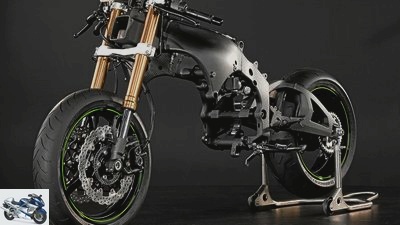
Kawasaki
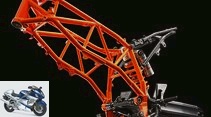
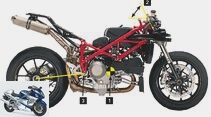
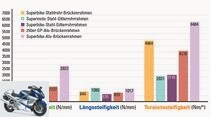
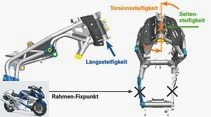
15th pictures

archive
1/15
The frame is crucial for the driving behavior.
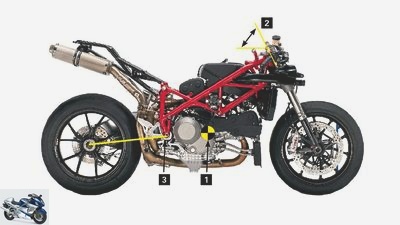
archive
2/15
When designing the main frame, the following parameters, among others, are set:
1) Position of the motor
2) Angle and position of the steering head
3) Total height of the swing arm bearing
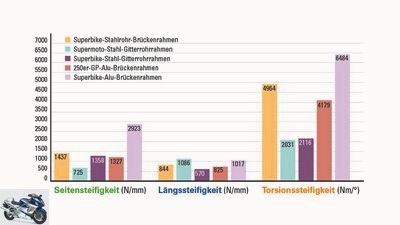
PS
3/15
The data for the different frame stiffness values come from a research and development department, so the types and manufacturers must remain anonymous, but the frame type and category may be named.
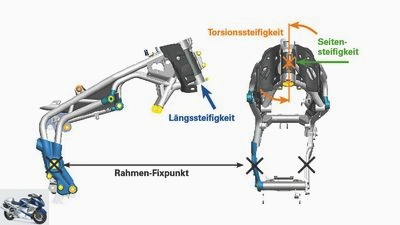
PS
4/15
Here you can see the different types of frame stiffness.

archive
5/15
Aluminum bridge frame, the second: the Yamaha MT 09 chassis screwed together from a left and right cast part (arrows). The cast parts, which are open on the inside, do not require a weld seam.
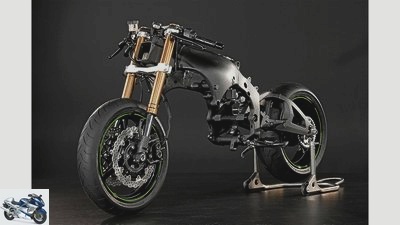
archive
6/15
Aluminum bridge frame, the second: the current Kawasaki ZX-10 R chassis on the left. The white lines show how the rigidly screwed motor expands the enclosed space with a triangular connection, thereby dramatically strengthening the construction.
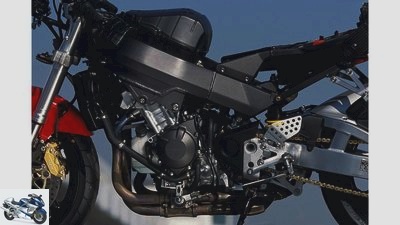
archive
7/15
Aluminum bridge frame, the first: Not only Honda saved the costly sheet metal parts and instead welded cheaper extruded profiles. In the case of the CBR 900 RR, type SC 50, the swing arm bearing in the frame (arrow), which is located here in the engine housing, was also saved.
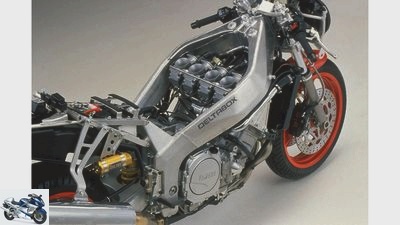
archive
8/15
Aluminum delta box frame: In the Yamaha FZR 750 RR from 1989, type OW 01, the engine was firmly screwed into a bridge frame made of beautifully welded aluminum sheets in the steering head area and cast parts for the swing arm / spring strut mount. Very expensive, very complex.
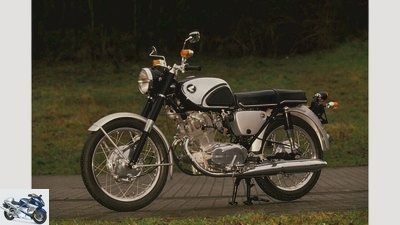
archive
9/15
Steel tube bridge frame: Honda reduced the frame tubes to a minimum in the CB 72 and CB 77 models at the end of the 1960s and made the ohc two-cylinder engine the load-bearing element. A construction principle for the future.
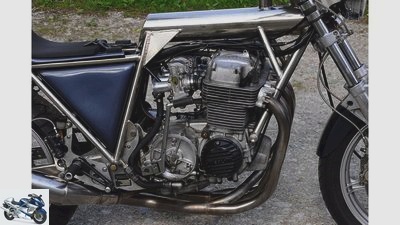
archive
10/15
Central tube frame: Fritz W. Egli made the powerful Japanese four-cylinder engines of the 1970s and 1980s legs with it. The mighty top tube of these frames was often used as an oil tank for dry sump lubrication.
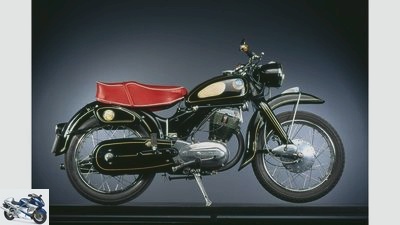
archive
11/15
Sheet steel frame: Here the construction of the NSU Max 250 welded from two deep-drawn sheet metal parts. The motor hung in the open frame on very delicate suspensions that did little to improve stability.
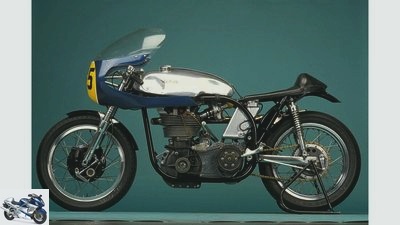
archive
12/15
Double-loop tubular steel frame: The classic frame design, as used, for example, in the duvet version of the Norton Manx. As the name suggests, the English were already focusing on targeted flexibility back then.
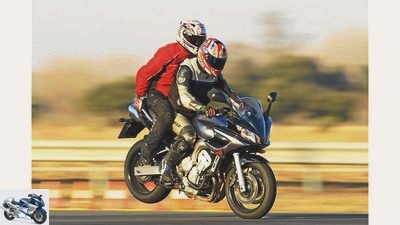
archive
13/15
Maximum load – during this braking process with a passenger, the entire vehicle weight is placed on the front wheel.
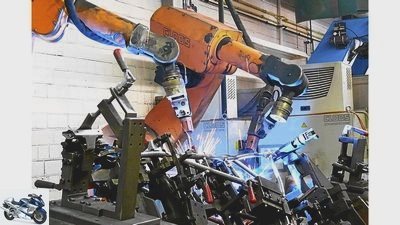
archive
14/15
The frame production: Large series frames are usually put together by welding robots.
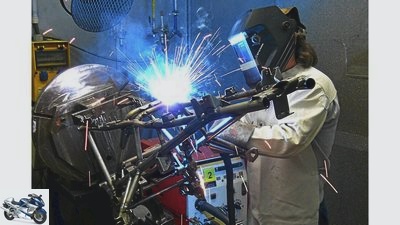
archive
15/15
But humans alone manage to make the nicer weld seams.
counselor
technology & future
Motorcycle frame types
PS-Technik series part 10
Types of motorcycle frames
Content of
The demands on motorcycle chassis are high. They should be stiff, but without brutal hardness, light but not fragile, and also inexpensive.
Werner Koch
01/21/2014
In the case of conventional motorcycle chassis of the post-war period, the name said it all. As a classic double loop frame, they spanned the entire motor and drive unit. This remained almost free of all torsional and bending forces that build up on a motorcycle frame. Often even stored in rubber elements to reduce vibrations, the motor housing and cylinder were literally decoupled in self-supporting frame structures. Only the continuous screw connection of the engine mounts from one frame side to the other contributed to the rigidity. Constructions made of welded sheet metal parts (e.g. Kreidler RS, NSU Max), single-tube frames (mopeds, light 125cc and enduro bikes) or the central tubular frame, which the Swiss Fritz W. Egli perfected for many powerful Japanese four-cylinder engines, were also widespread.
Buy complete article
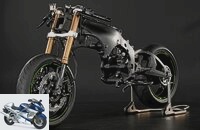
PS-Technik series part 10
Types of motorcycle frames
6 pages) as PDF
€ 2.00
Buy now
Clever designers simply cut off the projecting pipe beams on the double loop frame and replaced them with the motor screwed in at least three points. In the case of the filigree bridge frame of the CB 72, for example, at the end of the 1960s, Honda used the stiff engine housing as a bolted frame component in order to combine low weight and reduced material costs with good rigidity. This combination of the bridge frame has established itself in almost all modern sports motorcycles and is now standard.
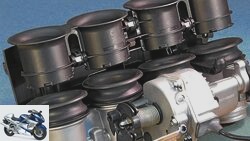
workshop
PS technology special
Further training for motorcyclists
read more
Serious key data determine the driving behavior
The same principle, but with a completely different technical and visual approach, was pursued by Ducati with its successful Supersport Twins until two years ago. Instead of aluminum or cast aluminum, the Italians use triangular, light and sufficiently stable steel tubes that integrate the engine. Ducati also uses the independent frame layout as a striking design element. Painted red and visibly displayed, Ducati and a few other Italians stand out from the Japanese mass-produced goods.
At the end of the 1980s, the 750cc Superbike icon Yamaha FZR 750 R (OW 01) made optimal use of the torsional stiffness of the composite construction, because the engine was completely rigid and without rubber elements. However, the motor housing had to be designed to be statically stable in order to be able to transmit the forces without damage. In particular, the sealing surfaces of the cylinder and cylinder head, which are screwed together using long tie rods, could warp and become leaky as a result of the forces introduced. One of the reasons that some manufacturers designed the load-bearing engine housing as a monoblock, in which the cylinder bank is firmly cast with the upper crankcase.
In order to prevent the cast aluminum parts of the frame from tearing under the tension of the motor bolts, the right-hand motor mounts can often be spaced out using threaded spindles so that the motor can be screwed on without tension. On the left side of the frame, on the other hand, the dimensionally milled screw connections ensure that the motor sits in the middle of the frame and that the chain line (alignment of front sprocket to rear sprocket) is one hundred percent correct.
If the rigidity is too high, the driving comfort suffers
In addition, the designers set a lot of key data for the frame, which have a serious effect on the driving behavior and can hardly be changed afterwards. In addition to the geometry data, these are also seemingly mundane things like steering angle or seat height.
Honda went one step further with the bridge frame of the CBR 900 RR and, like Ducati, stored the swing arm directly in the engine housing. The actual frame was shortened dramatically and became extremely light. However, such a compact design made the deliberately calculated flexibility of the frame more difficult.
This became necessary because the fork, wheels and tires were designed to be more and more rigid, especially in racing, and could hardly absorb bumps and bumps under extreme loads (inclines of up to 60 degrees and braking decelerations up to 14 m / s²). While the highest possible rigidity used to be part of the designer’s specifications, since the mid-1990s there has been an increasing search for a balance between stability and flexibility.
If the rigidity is set too high, the driving comfort and the feedback to the driver suffer. This means that the frame should support the suspension with a certain flexibility in the vertical direction in the steering head area, i.e. in the event of short, hard impacts (longitudinal stiffness). This flexibility of the frame is usually significantly greater in the case of longitudinal rigidity than in the case of lateral rigidity.
So that this flexibility does not affect the braking stability, cross struts welded or cast on behind the steering head prevent the frame profiles from spreading under pressure without stiffening the frame too much in the horizontal plane. If this triangulation is missing, the steering head, which is loaded to well over a ton, exerts so much pressure that the frame tubes or profiles that run around the engine form a veritable belly and give way to the outside. Problems that can be roughly simulated by computer calculations, but can only actually be proven in real driving tests.
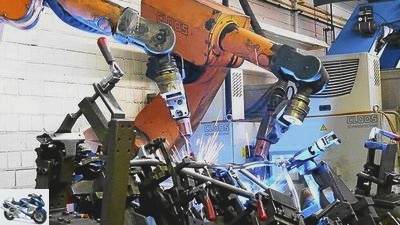
archive
The frame production: Large series frames are usually put together by welding robots.
The designers achieve the mix of the necessary rigidity and targeted flexibility by using walls and profile cross-sections of different thicknesses. Even with bolted and thus detachable stiffeners and cross connections, the Superbike and Moto GP frames can be changed in their flexibility depending on the route and the rider. The MotoGP teams show how complex and sometimes contradicting this chassis hocus-pocus can be. From one race to the other, frames are reinforced, then weakened again, in order to drive the rigidity to the extreme with even more material or carbon parts.
The brutal forces that actually apply to a motorcycle frame can be clearly demonstrated by applying the brakes with a pillion passenger and full compression on a touring bike weighing around 380 kilograms. These forces and moments in the barrel range are created by the lever action of the fork or the mechanical translation of the spring forces on the rocker arm.
And this is exactly where the most delicate task in frame construction lies. The frame has to withstand millions of force peaks over years and decades without becoming fatigued by the continuous load and ultimately bending or even breaking. With the loud call for extremely sporty lightweight construction, this is like walking a tightrope with blindfolded eyes.
Frame stiffness
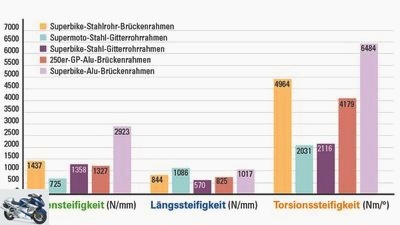
PS
Data of the different frame stiffness values.
The data for the different frame stiffness values come from a research and development department, so the types and manufacturers must remain anonymous, but the frame type and category may be named. These are motorcycles used in racing and therefore relevant. The values indicate the elastic deformation of the frame in millimeters or the angle of rotation in degrees. One newton corresponds to the weight of 0.10194 kilograms, i.e. 101.94 grams.
Lateral stiffness (in Newtons per millimeter)
The frame clamped on the swing arm bearing together with the motor (load-bearing component) is subjected to a lateral force acting horizontally on the steering head. The steering head gives way to the opposite side. As with a spring, the force is measured in Newtons per millimeter of deformation. Example: If the steering head on the Superbike aluminum frame is loaded with 2923 Newtons (corresponds to approx. 286 kilograms of weight), the frame bends sideways by one millimeter.
Longitudinal stiffness (in Newtons per millimeter)
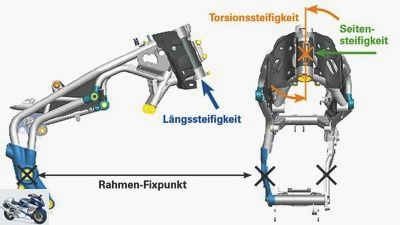
PS
Here you can see the different types of frame stiffness.
Here, too, the frame / motor assembly is fixed to the swing arm bearing. In this measurement, the steering head is loaded from below in the vertical direction, so the frame bends upwards. Example: With a load of 1017 Newtons (corresponds to approx. 99.7 kg), the steering head deviates one millimeter upwards, in the direction of the fork’s spring. Less effort is required to bend the frame than for lateral stiffness.
Torsional stiffness (in Nm per degree of twist angle)
Clamped on the swing arm bearing, the force acts via the one meter long lever at the center of the steering head. The resulting torque turns the steering head out of its vertical position. Example: To turn the steering head of the Superbike aluminum frame by one degree, 6480 Newtons, or in other words 635 kilograms, must be applied to the one-meter-long lever.
Framework values
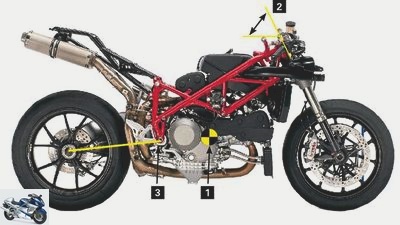
archive
When designing the main frame, five parameters are set.
When designing the main frame, the following parameters are set:
- Position of the motor (1) and the rotating masses in the vertical and horizontal position, thus influencing the overall center of gravity and weight distribution.
- Angle and position of the steering head (2) in the vertical and horizontal position, thus influencing weight distribution and wheelbase.
- Total height of the swing arm bearing (3) and height / distance to the chain sprocket, thus influencing anti-squad behavior and wheelbase.
- Flexural stiffness, lateral stiffness and torsional stiffness (see diagram on article page (2).
- Fatigue strength, which is tested by means of driving simulation on a so-called “pulser test stand”.
- Maximum breaking strength under extreme stress, which can be many times higher than the forces that occur during regular driving.
Related articles
-
archive counselor technology & future Technology frame types Technology explained Everything about frame types Full braking, marginal lean or full shower…
-
Technology: new motorcycle frame concept
Melly Technologies counselor technology & future Technology: new motorcycle frame concept Technology: new motorcycle frame concept Blockbusters With the…
-
The little ABC of motorcycle types, part two, E ?? H
Harley-Davidson motorcycles The little ABC of motorcycle types, part two, E ?? H The little ABC of motorcycle types, part two, E ?? H VSOP 850 FLHRSI…
-
The small ABC of motorcycle types, part 1 A ?? D.
Buell motorcycles The small ABC of motorcycle types, part 1 A ?? D. The small ABC of motorcycle types, part 1 A ?? D. ETV 1000 XB9R S4R Manufacturers…
-
EDIMO ?? Esslinger diesel motorcycle
fact motorcycles EDIMO ?? Esslinger diesel motorcycle EDIMO ?? Esslinger diesel motorcycle Ecology and fun The diesel motorcycle drives, and it does so…
-
counselor workshop Motorcycle engines: all types What you should know about engines Basics of engine types Depending on how many cylinders an engine has…
-
Cook 10 pictures Cook 1/10 If you doubt your driving ability because every curve radius becomes a hexagon and the motorcycle no longer meets a line, a…
-
PS reader question about motorcycle technology crash pads
Henniges 7th pictures Wiessmann 1/7 Picture gallery, technology: Are crash pads in makes sense in each case? Katrin Sdun 2/7 These crash pads are not…
-
PS reader question about motorcycle technology – cleaning the radiator
www.factstudio.de, Joachim Schahl 7th pictures archive 1/7 Picture gallery, technical question: cleaning coolers. Werner Koch 2/7 When the delicate…
-
Motorcycle legends and their successors
motorcycles Motorcycle legends and their successors Motorcycle legends and their successors Coveted forever Everyone knows them, many admire them….